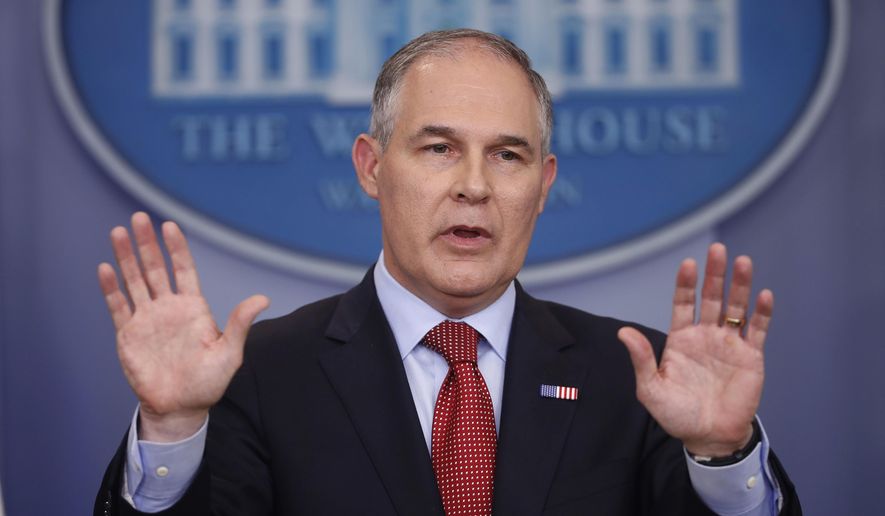After dismantling a host of Obama-era regulations in its first six months, President Trump’s Environmental Protection Agency has yet to begin what would be its toughest fight: reversing the agency’s 2009 endangerment finding on greenhouse gases, a game-changing document that laid the foundation for many of the environmental and climate change regulations that followed.
Challenging the endangerment finding — a technical scientific conclusion that greenhouse gases, including carbon dioxide, pose a threat to human health and must be regulated under the Clean Air Act — would be an uphill climb, specialists say, and would start an unprecedented legal war with environmentalists, states and a host of other litigants.
EPA Administrator Scott Pruitt has spoken at length of his deep desire to transform fundamentally his agency and move it back to its “core mission,” which he describes as making sure Americans breathe clean air and drink clean water. But he hasn’t said one way or the other whether he plans to go after the endangerment finding, which provided the legal underpinning for much of the Obama administration’s agenda inside the EPA.
Trying to do so could prove a futile exercise despite the pressure Mr. Pruitt has come under from conservatives, and sources familiar with the debate inside the EPA say the administrator believes the massive fight to kill the endangerment finding wouldn’t be worth the trouble.
“Reversing the endangerment finding would be a heavy lift. They would have to put together a scientific record showing that greenhouse gas emissions do not endanger public health or the environment, put their case out for public comment and then issue a final rule that responds to all the comments they would receive from researchers around the world,” said Jeff Holmstead, the former head of EPA’s office of air and radiation and a leading climate change lawyer at Washington’s Bracewell law firm.
“This would be a huge undertaking, and they might have a hard time finding EPA scientists who would work on it,” he said.
The endangerment finding, the culmination of more than two years of work at the EPA spanning two administrations, was born out of a 2007 Supreme Court decision.
In Massachusetts v. EPA, the court determined that the federal government needed to take a scientific look at whether greenhouse gases should be regulated under the decades-old Clean Air Act.
The case stemmed from state challenges to the EPA over its lack of regulation of greenhouse gases.
The results of that decision, and the subsequent two years of work inside the EPA, were the 2009 endangerment finding and its conclusion that carbon dioxide and other greenhouse gases are threats to human health. It then became the cornerstone of the Obama administration’s fuel standards for automobiles, its attempt to limit carbon emissions from power plants and a number of other regulations.
Because it was a direct response to an explicit court order, the endangerment finding seemed to be a unique legal commitment by the EPA to take action against greenhouse gas emissions.
“Once you find there’s a pollutant that’s causing an endangerment under the Clean Air Act, that triggers a number of things that you have to do,” said Bob Perciasepe, who served as deputy EPA administrator from 2009 to 2014 and now is president of the Center for Climate and Energy Solutions. “You have to review new sources of emissions to see what the best available control technology is.”
If Mr. Pruitt leaves the endangerment finding in place, then the EPA seemingly would have to address greenhouse gas emissions in some way, though it’s not entirely clear what courts would require the agency to do.
“There is a difference between what the endangerment finding requires EPA to do and what it authorizes EPA to do,” Mr. Holmstead said. “The people who want to reverse the finding aren’t too concerned about what it will require of the Trump EPA. They are hoping to prevent regulatory overreach from future administrations.”
Indeed, conservatives say the endangerment finding represents a key opportunity for Mr. Pruitt to change the EPA’s focus in the short run and to prevent future Democratic administrations from going back down the same regulatory road that the Obama White House began to pave.
The Paris climate treaty “and the endangerment finding are the two big outstanding issues. It’s the first wave of things that are necessary to turn this country around, particularly in the heartland states,” Myron Ebell, a climate change skeptic who headed Mr. Trump’s transition team at the EPA, said at a news conference in May.
The problem, as many specialists point out, is that the EPA couldn’t simply trash the endangerment finding.
The agency would have to produce its own rigorous scientific analysis — one that challenges the previous finding and tries to make a compelling argument that greenhouse gases, in fact, do not need to be regulated under the Clean Air Act.
Putting together such a legal and scientific argument would be difficult even without a host of lawsuits that courts could strike down.
“They would have to overcome all of that legal legacy and revisit all of the science,” said Christine Todd Whitman, who headed the EPA during the George W. Bush administration.
The EPA did not respond to a request seeking comment on its plans for the endangerment finding.
• Ben Wolfgang can be reached at bwolfgang@washingtontimes.com.




Please read our comment policy before commenting.